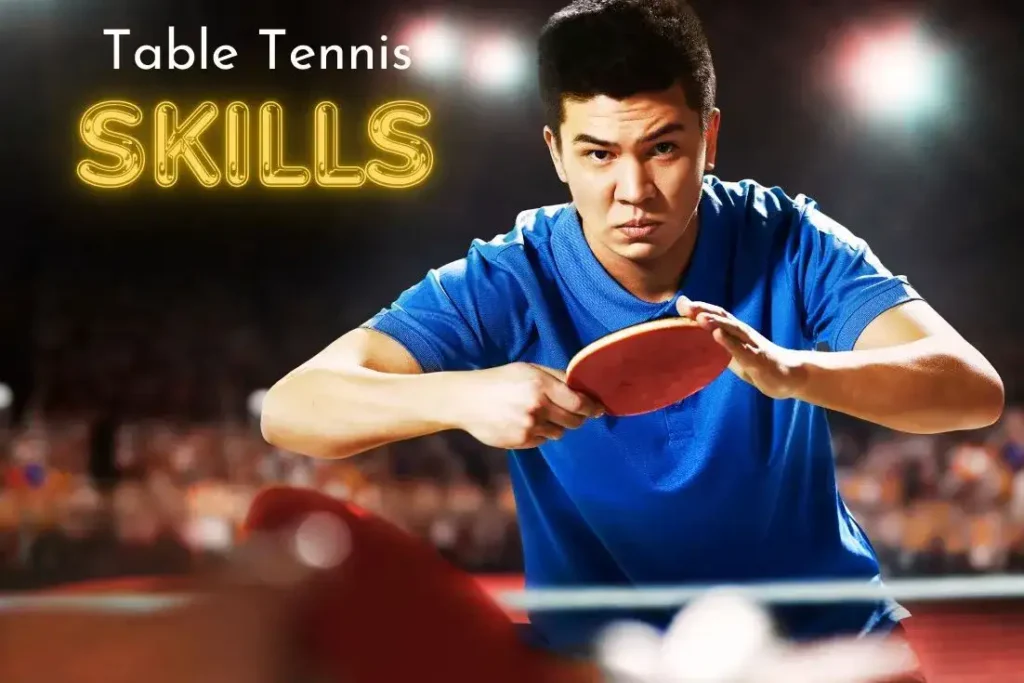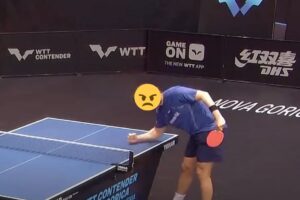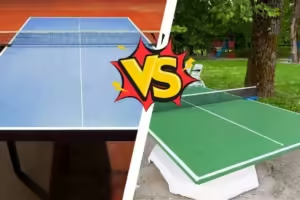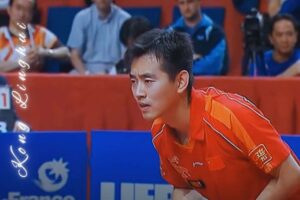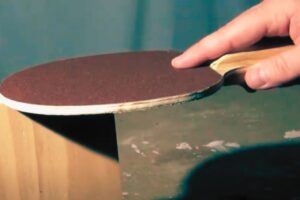Mastering table tennis skills is essential for elevating your game from casual play to competitive excellence. Whether you’re just starting or looking to refine your techniques, focusing on core competencies such as gripping, footwork and spin variations can make a significant difference.
Table tennis skills like the shakehand grip, forehand loops, and strategic footwork form the foundation of a well-rounded player. This article will guide you through the essential skills every beginner needs to master, helping you develop the techniques necessary to dominate the table.
With dedicated practice and a focus on these fundamental skills, you’ll be well on your way to becoming a formidable table tennis competitor.
Remember key lessons for players starting:
- Use proper shakehand grips for control or penhold for quick resets
- Loop topspin forehands for power and flick backhands for deception
- Integrate spin variations with sidespin serves and underspin blocks
- Maintain dynamic footwork getting into balanced positioning
- Construct smart shot plans targeting specific opponent weaknesses
Why Master Table Tennis Basics?
Casual ping pong may be fun, but proper grips and strokes elevate the game. Competitive games demands high-level table tennis skills, differing greatly from its parlor game origins. Rallies can exceed 70mph, requiring mastery of spins, placements, and pace variation.
Learning correct techniques, including grip, serves, and avoiding early habits, sets a strong foundation for improvement. Mastering fundamentals like grip, footwork, spin, and tactics sets the stage for elite play, emphasizing the importance of embracing these basics.
Gripping Techniques: Shakehand and Penhold Fundamentals
Unlike bigger racquet sports, table tennis requires considerable finger finesse for brushing significant spin on the 40mm ball. The grip connects your hand directly to the paddle influencing stability and angle control. Two primary grip types exist in competitive table tennis:
The Shakehand Table Tennis Grip
The shakehand grip represents the most popular way to hold a paddle mimicking the position of a handshake. Pressure from the thumb bent across the rubber surface grips the racket while the index finger locked along the backside stabilizes it for striking.
This grip enables versatile offense and defense integrating forehands, backhands, serves, and spin variations. Most competitive players use the shakehand style exclusively due to its control and flexibility.
Understanding the Penhold Grip Table Tennis Skills
The penhold grip involves clutching the paddle handle between the thumb and index finger resembling how one holds a writing instrument. This grip style traces its origins to table tennis in Asia before spreading worldwide in the 90s and 2000s.
Less versatile than shakehand, penhold grips specialize in quick handle reflexes for deceptive placements often from close-to-the-table exchanges. Ready positioning for paddle faces supports blocking and driving underspin. However, shakehand flexibility makes it more popular in the West.
Incorporating both grips enhances shot variety selections and strategic advantage.
Forehand and Backhand Stroke Technique
Now that proper grip fundamentals are covered, next involves learning table tennis’ chief attacking strokes – the forehand and backhand topspin drives. Powerful rotation placed across the table or directed wide pins opponents into defensive footwork patterns.
Let’s break down both stroke forms:
Forehand Drive Mechanics
The forehand drive represents table tennis’ most natural stroke with full arm extension like a baseball swing. Its friendly mechanics make forehands easily accessible even for beginners first starting.
Stand sideways with feet staggered one in front of the other. Transfer weight rotating the torso and sweeping high to low across your body for full reach on contact. Steps synchronize with swing tempo for balance and momentum.
Make sure contact happens out in front with the racket face brushing upward on the ball. This imparts topspin adding speed post-bounce. Follow through carrying across your torso.
Executing the Backhand Drive Attack
Due to centrally positioned shots closer inward, backhand drives activate different mechanics from forehands. Strokes remain compact activating the elbow, wrist, and fingers for fast flicks toward corners rather than wide swings.
Pivot sideways on the front foot while uncoiling the elbow joint straight forward. Control aim by adjusting paddle angle mid-stroke to deceive opponents on placement. Follow through rises to shoulder height then extends directly outward instead of across the body after contact.
Backhands rely on explosive smaller muscle groups in fingers and wrists for working spins and angles. Rapid hand-eye coordination, anticipation, and reflexes separate solid techniques from rigid unreliable ones.
Both drives become weapons once rhythm and spins integrate more fluently.
Serving Techniques: The Foundation Rally Shots
The serve in table tennis takes on enhanced importance compared to other racket sports since it must be returned or conceded the point. Beyond starting rallies, strategically variating speed, spin, and placement also earns advantages by ticking off receiver errors.
Let’s examine the fundamentals every player should know for exploiting services:
- Hide stroke motions until the last second by concealing the ball in hand during toss prep. Release at peak so it descends onto the table for optimal striking
- Slice sidespin serves to target the wide tramline curve out wide then veer off table edges past the receiver paddle.
- Alternate textbook wrinkle-spin serves with unreadable placements diving long/short supported by proper technique.
- Change grip configurations between forehand and backhand serves to bolster deception and angles.
Place short no spin placements down the line on weaker wings baiting weak returns. Mix up-tempo and trajectory so opponents cannot assume repetitive locations.
The foundation’s eyes on the ball, stable base, and controlled extension set up every impressive table tennis serve.
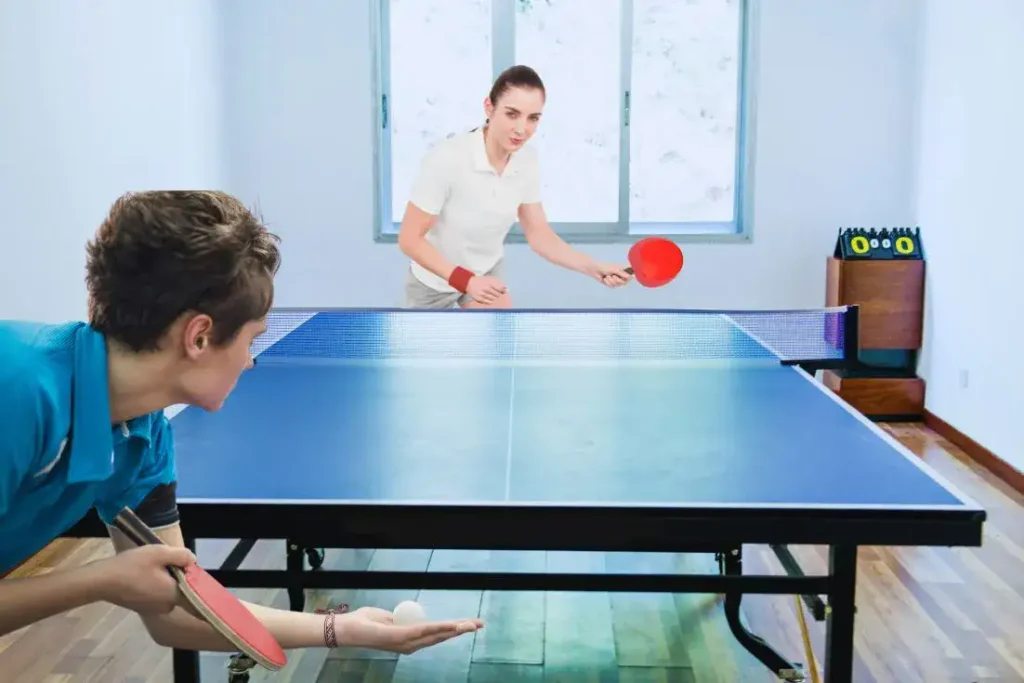
Pushes and Flicks: Control Fundamentals
Table tennis point construction frequently builds upon short game exchanges like pushes and touch shots integrating placement chops waiting for counter-hitting opportunities.
Let’s examine essential techniques that make these tricky balls possible:
The Backhand Push
This gentle defensive stroke floats underspin back deep utilizing proper timing, feel, and precision. Striking the bottom half of the ball brushing downward maintains rally momentum while neutralizing pace. Utilize when stuck defensive or awaiting chances to counterattack.
Flicking Counterhits
When opportunities arise, explode forward off the bounce flicking topspin toward the open court just over net height. Strike firmly using nimble wrists and paddle face finesse to caress spins. Follow through toward intended targets. Move back afterward reestablishing positioning.
Sharpening pushes and flick proficiencies bolster table tennis versatility critical toward shot modifications seen at the highest professional levels.
Spinning Methods: Topspin and Underspin Essentials
Competitive table tennis integrates significant rotations and pace changes beyond hitting purely flat. Grappling with extreme underspin and topspin differentiates novice from formidable intermediate players on upward. This section provides fundamentals for generating both capabilities.
Topspin bites the bounces downward after striking the table so opponents must address lower with fast reflexes. Sweeping upward paddle face acceleration through impact throws topspin forward off the bounce.
Underspin (also called backspin) makes the ball jump off the table in reverse floating upward while curving down on the other side. Contact underneath with a downward brush imparts this reverse force to bewilder opponents.
Introduce spins slowly at first through repetition focusing on clean contacts. Observe ball behavior coming off the table afterward. Then intensify rotations increasing pace and placements varieties.
Do not underestimate the importance of spin or else get prepared to retrieve lots of crazy balls later!
Footwork Fundamentals
Speedy responsive footwork represents the overlooked foundation separating competent table tennis players from weekend hobbyists struggling to rally consistently. Explosive steps characterize elite professional dynamic exchanges once sticking foot basis sets up each shot sequence.
- Maintain a ready position with feet apart, knees bent and weight centered for reactive mobility.
- Use split steps and small shuffles to reach shorter shot selections with perfect timing.
- Sprint, pivot, and change pace chasing down distance balls dropped short or directed wide
- Always return centrally to a balanced ready footing after every shot selection.
Crisp acceleration, direction switches, and weight transfers must become second nature not to reach balls in the time. There are no shortcuts to ingraining smooth rapid table tennis footwork over hundreds of focused hours. Put the work in, and you’ll reap huge dividends later, significantly improving your overall table tennis skills!
Basic Game Tactics: Playing Smart Ping Pong
Beyond just hitting, table tennis integrates considerable mental acuity, pattern recognition, and matchup analysis like chess with paddles. Distilling thousands of shape combinations into strategic plans gives direction toward point construction targeting specific opponent weaknesses.
Keep rallies simple at first while making a few mistakes and seeing how opponents play under pressure. Analyze tactical habits like where they serve, favored strokes, footwork limitations, and trouble hitting certain spins.
Look to maneuver opponents into backhand corners with spinny loops then strike surgically back down the line once resistance softens. Or wrong-foot defenders with sharply angled placements made more extreme after setting up patterns.
Squash balls quickly recognize late bounces and losses in power better than letting negatives compound over many points. Maintain high alertness through changing circumstances to outthink adversaries.
Common Mistakes to Avoid
Striving to advance your ping pong game rapidly? Be vigilant toward avoiding these common amateur flaws sabotaging improvement:
Poor Ready Position – Standing upright flat-footed severely delays mobility to reach balls efficiently
Limited Grip Versatility – Locking into backhands despite surrounding forehand opportunities limits attacking capabilities
Over-Swinging – Launching full shots powerfully without control leads to excessive errors
Stroke Rigidity – Depending too much on arm strength reduces wrist snap and spin capability
Ignoring Footwork – Neglecting split steps and recovery time hampers positioning
Lack of Tactical Adaptation – Failing to recognize and counter what techniques succeed against you each match
Mitigate these typical weaknesses manifesting through better-learned fundamentals to unleash your full competitive table tennis potential!

Also See: Avoid Critical Mistakes: Touch the Table in Table Tennis.
Practice Routines To Develop Table Tennis Skills
Greatness emerges not just through enthusiasm and athletic potential but maniacal dedication toward targeted drills ingraining technique into reflexive habits. Tackle the following training routines to accelerate skillset upgrades:
Serve & Return – Land different service varieties strategically while refining receiver proficiency
Forehand Loop Consistency – Sustain looping drives from both wings toward centered backspin training robotically
Backhand Variety – Flick angles mixed with compact quick blocks dancing at the table edge for agility
Spin Identification – Read spin types by ball behavior and visual clues, adjust accordingly focusing on control
Footwork & Recovery – Hop sequences touching floor dots that light up randomly with fast reset steps
Ball Placement Precision – Target-specific court coordinates frequently changing spin and trajectories
Program fundamentals practice so it stretches technical capabilities beyond their usual thresholds into consistent stability. Treat excellence as the gradual accumulation of corollary competencies aligned toward unified Come prepared to put in the work!
Equipment Basics: Racket Specs and Rubbers
Competitive table tennis integrates carefully customized racket specifications matching offensive or defensive player strengths through unique rubber, sponge, and blade combinations affecting speed, spin, and control.
Let’s demystify key dimensions differentiating setups:
Blade Composition – Differing lightweight wood plies boost touch sensitivity for control or stiffen for power. Carbon and graphene layers add speed across paddle faces. Customize accordingly!
Rubber Textures – Pip-out inverted rubber surfaces grip the ball for a heavy spin while smooth no-pip faces increase catapult speed given indentations and tension levels. Harder sponges quicken the pace as softer ones provide disruption. High tension = more pop!
Racket Handles –Straight handle styles assist forehand acceleration in open strokes while anatomic side protections reinforce firmer leverage supporting shakehand flexibility. Length and shape enable comfort!
Do not neglect the, dialing blade, rubber and handles to support developing play styles and optimizing strengths!
Etiquette and Sportsmanship
Table tennis, even in casual play, demands respect for opponents’ skill levels. Etiquette, from avoiding delays to ensuring clear sightlines, fosters enjoyable games. Minimize sideline distractions, especially during crucial moments like service tosses. Accept referee decisions gracefully and celebrate great plays rather than dwelling on mistakes.
Maintain friendly interactions with rivals but leave competitiveness on the table. Strive for excellence through performance and inspiration rather than empty boasts. These etiquette tips ensure a respectful and enjoyable ping pong experience for all players, enhancing their table tennis skills. Now, play fiercely but respectfully!
FAQs
Q: What are the four basic table tennis strokes?
Ans: The four basic table tennis strokes are the forehand drive, backhand drive, forehand push, and backhand push.
Q: How do I improve my footwork in table tennis?
Ans: You can improve your footwork in table tennis by practicing basic drills, focusing on your balance, and maintaining a low stance to move quickly and efficiently.
Q: What are the essential table tennis skills for beginners?
Ans: Essential table tennis skills for beginners include mastering the basic strokes, learning proper footwork techniques, understanding the rules of the game, and developing consistency in your shots.
Q: What are the basic techniques for serving in table tennis?
Ans: Basic techniques for serving in table tennis include mastering the forehand and backhand service, utilizing various spins, and aiming for accuracy and placement on the opponent’s side of the table.
Q: How can I advance my table tennis game?
Ans: You can advance your table tennis game by focusing on improving your table tennis skills and techniques, refining your strokes, practicing regularly, and maintaining a strong mental focus during matches.
Q: What is the importance of being close to the table in table tennis?
Ans: Being close to the table in table tennis allows players to have better control over the ball, react more quickly to their opponent’s shots, and apply pressure with aggressive gameplay.
Q: What equipment do I need to play table tennis?
Ans: To play table tennis, you will need a table tennis racket, table tennis balls, and access to a suitable table tennis playing surface, such as a table designed specifically for the game.
Q: What are the basic rules of table tennis?
Ans: The basic rules of table tennis include serving diagonally, allowing the ball to bounce once on each side of the table, and scoring points based on successful rallies and errors made by the opponent.
Conclusion
In conclusion, honing your table tennis skills is crucial for achieving competitive success and enjoying the game to its fullest. By mastering fundamental techniques such as proper grips, effective footwork, and strategic spins, you’ll gain a significant advantage over your opponents.
Remember, consistent practice and a focus on these essential table tennis skills will lead to steady improvement and confidence in your play. Whether you’re aiming to compete at a high level or simply enhance your recreational play, embracing these core skills will set you on the path to excellence. Keep practicing, stay motivated, and watch your table tennis game reach new heights.
